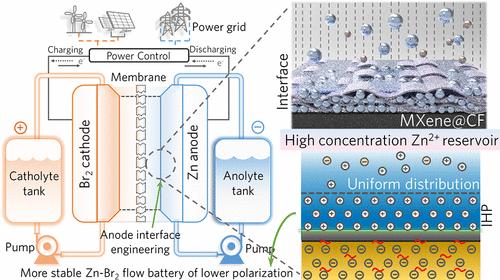长循环高效锌-溴液流电池锌阳极高浓度Zn2+阳离子储层的构建
IF 18.2
1区 材料科学
Q1 CHEMISTRY, PHYSICAL
引用次数: 0
摘要
锌溴液流电池(ZBFBs)由于其安全性和低成本,在大规模储能领域具有很强的竞争力。然而,锌阳极内部亥姆霍兹平面(IHP)内Zn2+分布不稳定,往往导致枝晶生长和严重极化,特别是在高速率和长时间的条件下。在这项工作中,我们将具有强Zn2+阳离子承载能力的MXene纳米片引入碳毡(MXene@CF),在电极-电解质界面形成“Zn2+储层”,稳定IHP并防止枝晶的形成。MXene@CF电极的高电导率、低活化能势垒和富含Zn2+的IHP分别缓解了欧姆极化、活化极化和浓度极化,从而降低了整体电压极化,提高了能量效率。含有MXene@CF的zbfb在20 mAh cm-2和20 mA cm-2下保持1000小时以上的稳定循环,平均能量效率接近85%。本文章由计算机程序翻译,如有差异,请以英文原文为准。

Building a High-Concentration Zn2+ Cation Reservoir of Zn Anode for Long-Cycling and High-Efficiency Zinc–Bromine Flow Batteries
Zinc–bromine flow batteries (ZBFBs) are highly competitive for large-scale energy storage due to their safety and low cost. However, unstable Zn2+ distribution within the inner Helmholtz plane (IHP) of the Zn anode often leads to dendrite growth and severe polarization, especially under high-rate and long-duration conditions. In this work, we introduce MXene nanosheets with strong Zn2+ cation hosting capability onto carbon felt (MXene@CF), which form a “Zn2+ reservoir” at the electrode–electrolyte interface, stabilizing the IHP and preventing dendrite formation. The high electric conductivity, low activation energy barrier, and Zn2+-enriched IHP of the MXene@CF electrode collectively alleviate the Ohmic polarization, activation polarization, and concentration polarization, respectively, thus reducing overall voltage polarization and improving energy efficiency. ZBFBs with MXene@CF maintain stable cycling for over 1000 h at 20 mAh cm–2 and 20 mA cm–2 with an average energy efficiency of nearly 85%.
求助全文
通过发布文献求助,成功后即可免费获取论文全文。
去求助
来源期刊

ACS Energy Letters
Energy-Renewable Energy, Sustainability and the Environment
CiteScore
31.20
自引率
5.00%
发文量
469
审稿时长
1 months
期刊介绍:
ACS Energy Letters is a monthly journal that publishes papers reporting new scientific advances in energy research. The journal focuses on topics that are of interest to scientists working in the fundamental and applied sciences. Rapid publication is a central criterion for acceptance, and the journal is known for its quick publication times, with an average of 4-6 weeks from submission to web publication in As Soon As Publishable format.
ACS Energy Letters is ranked as the number one journal in the Web of Science Electrochemistry category. It also ranks within the top 10 journals for Physical Chemistry, Energy & Fuels, and Nanoscience & Nanotechnology.
The journal offers several types of articles, including Letters, Energy Express, Perspectives, Reviews, Editorials, Viewpoints and Energy Focus. Additionally, authors have the option to submit videos that summarize or support the information presented in a Perspective or Review article, which can be highlighted on the journal's website. ACS Energy Letters is abstracted and indexed in Chemical Abstracts Service/SciFinder, EBSCO-summon, PubMed, Web of Science, Scopus and Portico.
 求助内容:
求助内容: 应助结果提醒方式:
应助结果提醒方式:


